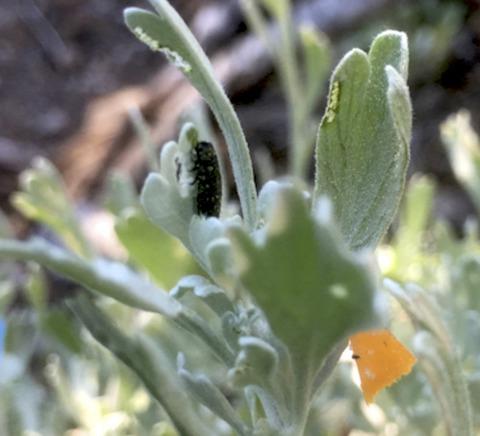当前位置:
X-MOL 学术
›
J. Anim. Ecol.
›
论文详情
Our official English website, www.x-mol.net, welcomes your feedback! (Note: you will need to create a separate account there.)
Feeding and damage‐induced volatile cues make beetles disperse and produce a more even distribution of damage for sagebrush
Journal of Animal Ecology ( IF 4.8 ) Pub Date : 2020-06-25 , DOI: 10.1111/1365-2656.13270 Richard Karban 1 , Louie H Yang 1
Journal of Animal Ecology ( IF 4.8 ) Pub Date : 2020-06-25 , DOI: 10.1111/1365-2656.13270 Richard Karban 1 , Louie H Yang 1
Affiliation

|
1. Induced plant responses to herbivory are common and we have learned a lot about the mechanisms of induced resistance and their effects on herbivore performance. We know less about their effects on herbivore behavior and especially on spatial patterns of damage. 2. Theoretical models predict that induced responses can cause patterns of damage to become aggregated, random, or even. A recent model predicted that informed herbivore movement coupled with communication between plants would make damage more even within individual plants. We tested these predictions in the field using a specialist beetle (Trirhabda pilosa) that feeds on sagebrush (Artemisia tridentata). Both the beetle and the plant are well-documented to respond to damage-induced volatile cues. 3. Beetle larvae were more likely to move from damaged leaves and leaves that had been exposed to volatiles from nearby damaged leaves compared to undamaged control leaves. Previous lab results indicated that beetles were more likely to choose undamaged leaves compared to damaged leaves or those exposed to volatile cues of damage. 4. A comparison of damage patterns early in the season and after completion of beetle feeding revealed that variance in damage among branches decreased as the season progressed; i.e., damage became more evenly distributed among the branches within a plant. Larvae damaged many leaves on a plant but removed relatively little tissue from each leaf. 5. Herbivore movement and the spatial patterns of damage that it creates can be important in determining effects on plant fitness and other population processes. Dispersion of damage deserves more consideration in plant-herbivore studies.
中文翻译:

摄食和损伤诱导的挥发性线索使甲虫分散并为山艾树产生更均匀的损伤分布
1. 植物对食草动物的诱导反应很常见,我们已经了解了很多关于诱导抗性的机制及其对食草动物性能的影响。我们对它们对食草动物行为的影响,尤其是对损害空间模式的影响知之甚少。2. 理论模型预测,诱发反应会导致损害模式变得聚集、随机或什至。最近的一个模型预测,知情的食草动物运动加上植物之间的交流会使单个植物受到更大的损害。我们使用以山艾树(Artemisia tridentata)为食的专家甲虫(Trirhabda pilosa)在现场测试了这些预测。甲虫和植物都有据可查,可以对损伤引起的挥发性信号做出反应。3. 与未受损的对照叶片相比,甲虫幼虫更有可能从受损叶片和暴露于附近受损叶片挥发物的叶片中移动。先前的实验室结果表明,与受损的叶子或暴露于易变的损坏线索的叶子相比,甲虫更有可能选择未损坏的叶子。4. 季节早期和甲虫喂养完成后的损害模式比较显示,随着季节的进行,树枝间的损害差异减少;即,损害变得更均匀地分布在植物内的分支中。幼虫损坏了植物的许多叶子,但从每片叶子上去除的组织相对较少。5. 草食动物的运动及其造成的损害空间模式对于确定对植物适应性和其他种群过程的影响很重要。
更新日期:2020-06-25
中文翻译:

摄食和损伤诱导的挥发性线索使甲虫分散并为山艾树产生更均匀的损伤分布
1. 植物对食草动物的诱导反应很常见,我们已经了解了很多关于诱导抗性的机制及其对食草动物性能的影响。我们对它们对食草动物行为的影响,尤其是对损害空间模式的影响知之甚少。2. 理论模型预测,诱发反应会导致损害模式变得聚集、随机或什至。最近的一个模型预测,知情的食草动物运动加上植物之间的交流会使单个植物受到更大的损害。我们使用以山艾树(Artemisia tridentata)为食的专家甲虫(Trirhabda pilosa)在现场测试了这些预测。甲虫和植物都有据可查,可以对损伤引起的挥发性信号做出反应。3. 与未受损的对照叶片相比,甲虫幼虫更有可能从受损叶片和暴露于附近受损叶片挥发物的叶片中移动。先前的实验室结果表明,与受损的叶子或暴露于易变的损坏线索的叶子相比,甲虫更有可能选择未损坏的叶子。4. 季节早期和甲虫喂养完成后的损害模式比较显示,随着季节的进行,树枝间的损害差异减少;即,损害变得更均匀地分布在植物内的分支中。幼虫损坏了植物的许多叶子,但从每片叶子上去除的组织相对较少。5. 草食动物的运动及其造成的损害空间模式对于确定对植物适应性和其他种群过程的影响很重要。



























 京公网安备 11010802027423号
京公网安备 11010802027423号